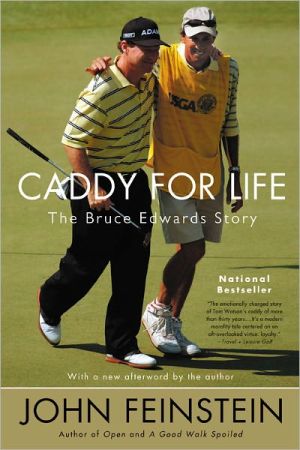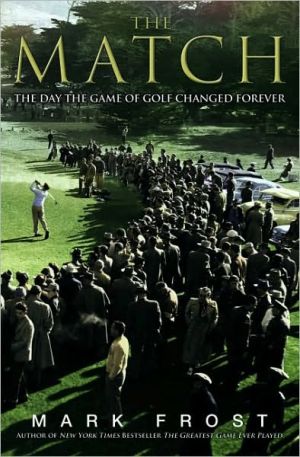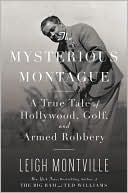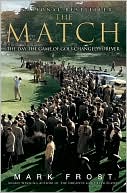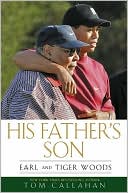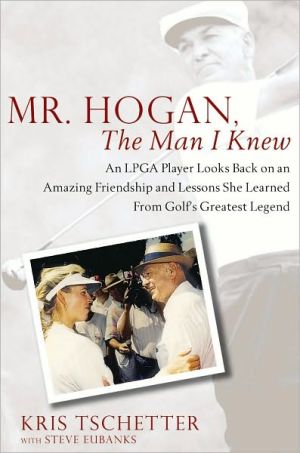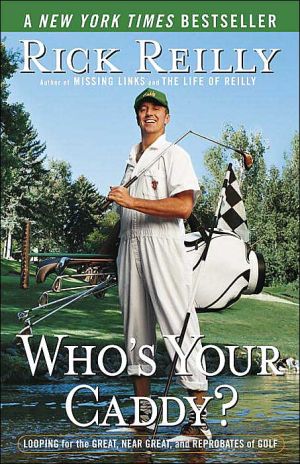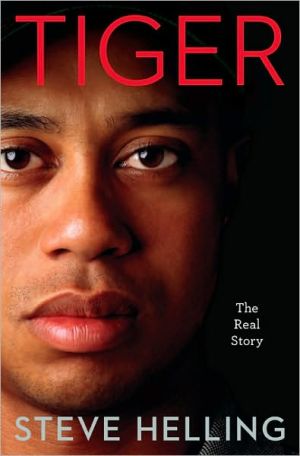Caddy for Life: The Bruce Edwards Story
Beyond golf's polished surface there lies a world not often seen by the average fan. The caddy sees everything - the ambition, the strategy, the rivalries, the jealousies - that occurs behind the scenes. Award-winning John Feinstein, America's favourite sportswriter, got one of golf's legendary caddies to reveal the secrets behind the most popular sport of our time. Bruce Edwards was diagnosed with Lou Gehrig's disease in January 2003, a progressive disease that attacks nerve cells in the...
Search in google:
Beyond golf's polished surface there lies a world not often seen by the average fan. The caddy sees everything - the ambition, the strategy, the rivalries, the jealousies - that occurs behind the scenes. Award-winning John Feinstein, America's favourite sportswriter, got one of golf's legendary caddies to reveal the secrets behind the most popular sport of our time. Bruce Edwards was diagnosed with Lou Gehrig's disease in January 2003, a progressive disease that attacks nerve cells in the brain and the spinal cord, but he dominated coverage of the 2003 US Open. This is a position not usually bestowed on a caddy, but Edwards was no ordinary caddy. In 1973, after forgoing college, Edwards walked on the course behind a young Tom Watson and never looked back. Watson would go on to win eight major titles with Bruce Edwards by his side. Edwards continued to do the job he had dedicated more than half his life to right up to his death in April 2004, aged 49. This is a moving, dramatic and thoughtful book about a life devoted to sports. Publishers Weekly Sportswriter Feinstein (Open; The Majors) delivers another solid look at the world of golf and its many interesting personalities, and this newest is his most intimate work so far. His subject is Bruce Edwards, who has been known within golf's tight-knit world as the caddy for over 40 years for legendary pro Tom Watson. Edwards's life story is a microcosm of the changes in modern professional golfing, and this book will thoroughly entertain golf fans. The personal edge in Feinstein's writing comes from the fact-acknowledged immediately in the book's introduction-that Edwards was diagnosed in 2003 with ALS, Lou Gehrig's disease, and that he found this out only 15 days after proposing to the longtime love of his life. Fortunately, Feinstein is skilled at looking at Edwards's professional and personal challenges without becoming mawkish and delivers a solid testament to a life well led. Feinstein nicely captures how Edwards, by caddying for Watson, "became the public face of those changes"-from Edwards's teenage years, working only at individual clubs for small change with a range of golfers competing for purses that were one-thirtieth of what they are now, to today, when a caddy can make an annual income well into six figures working for a successful player. The book, in effect, also offers a fine bio of Watson, as Feinstein recounts in energetic detail the many important tournaments that Watson won with Edwards's assistance. Agent, Esther Newberg. (Apr.) Copyright 2004 Reed Business Information.
CADDY FOR LIFE\ The Bruce Edwards Story \ \ By John Feinstein \ Little, Brown & Company\ Copyright © 2004 John Feinstein and Bruce Edwards\ All right reserved.\ ISBN: 0-316-77788-9 \ \ \ Chapter One\ The Reunion \ TO BE IN NEW ENGLAND on the first Saturday in September when the Red Sox are in a pennant race, when college football is beginning again and the first hints of fall are in the air, is to be about as close to heaven as one can come while still on earth.\ On just such a day in 2003, on a morning when the sky was brilliantly blue and the temperature at sunrise was in the low 60s, a far-flung family gathered at 416 Brenda Lane in Franklin, a Boston suburb about twenty-five miles southwest of Kenmore Square and Fenway Park. Jay and Natalie Edwards had driven from their retirement home in Vero Beach, Florida, stopping in Annapolis on the way to spend a little extra time with their daughter Chris, her husband, John, and their two children. Chris, the oldest of the four Edwards children, is, like her husband, a retired Navy veteran. After Jay and Natalie continued their drive north, Chris and her family flew into Boston on Friday night.\ Brian, the second son, and his wife, Laurie, had the longest trip, coming from their home in Steamboat Springs, Colorado. They had flown east on Wednesday and had spent time on Cape Cod riding bicycles and roller-blading. Rare was the day in their lives when they didn't bike or run or blade or look for something new and different-to attempt. Gwyn and Lenny were the only ones who didn't have to travel, because they were the hosts, which meant they had the most work to do. That was how they wanted it, though, especially Gwyn, the baby in the family. She had retired from a successful career in public relations to raise their three children, who now ranged in age from five and a half to two and a half. It was Gwyn who had first come up with the idea to get everyone together and Gwyn who had pushed everyone else to make sure it happened.\ Technically this was not a reunion but a chance to celebrate the wedding of Jay and Natalie's son Bruce. Bruce, the second child and the first son, had married Marsha Cummins Moore on a beach in Hawaii in February, almost thirty years after they first met and five weeks after they had become engaged.\ The engagement had caught the family a little off guard; they hadn't known there was someone serious in Bruce's life. The wedding had been a complete surprise, because it had all happened in less than a week. Hilary Watson, whose husband, Tom, had been Bruce's boss for almost his entire adult life, had suggested it to Marsha on a Monday and the ceremony had taken place six days later on the beach. Friends had commented that it was typical of Bruce to find a way to get married in his bare feet.\ Tom Watson was Bruce's best man. In his toast to the bride and groom he had commented that this was a marriage that was beginning under very difficult circumstances. "The groom," he said, "is a lifelong Eagles fan. The bride is a devoted Cowboys fan. That's why it took so long for them to finally get together. Clearly, they are going to have a lot of work to do."\ When the rest of the family heard about the wedding, they were taken by surprise, but they also understood. Everyone talked about getting together at some point at Bruce and Marsha's home in Florida to celebrate. But there was no specific date or plan. Late in March, as was almost always the case on weekends, Gwyn and Lenny had the TV tuned to that week's golf tournament. It was the Players Championship. Gwyn was walking through the living room when she heard NBC's Jimmy Roberts mention the name Bruce Edwards.\ She stopped and sat down. A moment later her big brother was on the screen. She took a deep breath when she saw him and tried not to cry.\ Bruce's voice was thick, his words difficult to understand, almost as if he'd been drinking. That wasn't a surprise, because she'd talked to him on the phone frequently in the weeks since the wedding and knew that was how he sounded now. "But I hadn't seen him," she said. "When I saw how thin he was, when I saw how different he looked in just a few weeks, that's when it really hit me. That was when I first thought to myself, 'We have to get everyone together - soon.'"\ Months later, sitting on a couch in the living room with Lenny next to her, she still found it difficult to say exactly why the thought had crossed her mind that day. "I don't honestly remember if I thought it specifically," she said. "But obviously it was somewhere in my mind."\ Somewhere in her mind was the thought that couldn't be avoided - not on that afternoon in March nor on that spectacular Saturday in September: If we don't get the family together soon, the next time might be at Bruce's funeral.\ Three weeks before Bruce's wedding, at the age of forty-eight, an unsmiling doctor at the Mayo Clinic had said to him, "Do you know what ALS is? It's also known as Lou Gehrig's disease. In all likelihood, you have one to three years to live."\ Just like that. No ifs or ands or buts. He had issued what was, essentially, a death sentence, almost as if he were a judge telling a criminal his decision based on the facts before him.\ That had been on a cold, snowy January day in Minnesota. A lot had happened since then, much of it good, some of it extraordinary. Bruce had been to many different doctors and had been told many different things about how he could get better. But the disease was still progressing. Bruce knew it, Marsha knew it, the family knew it.\ When Bruce and Marsha arrived at Gwyn and Lenny's house that Friday night in September, there was a plate of mussels, courtesy of Brian and Laurie, sitting on the table on the back patio that Lenny had managed to finish building in time for the weekend. "Try a couple," Brian advised his older brother. "They're delicious."\ "Great," Bruce said with the wicked smile that was his trademark. "Can they cure ALS?"\ Everyone laughed. It was a funny line, typical Bruce. And then everyone sat back and the cool evening was completely silent for a moment.\ In all there were seventeen of them gathered at 416 Brenda Lane, the house that Gwyn and Lenny had moved into ten months earlier. In addition to Jay and Natalie Edwards, the patriarch and matriarch, and their four children and their spouses, there were seven children, ranging in age from fifteen-year-old Natalie, John and Chris's oldest, down to little Jay, Lenny and Gwyn's youngest. Gwyn and Lenny had rented a moon-bounce for the weekend, and it proved to be a masterstroke, keeping the kids busy with little squabbling. That left the adults time to sit on the patio, enjoy the spectacular weather, wonder if the Red Sox might finally be for real, and of course reminisce and remember.\ "Thank God Bruce was always the kind of kid who stuck to his guns," Jay Edwards said on Friday evening, shortly before Bruce arrived.\ "Those first few years, we kept waiting for him to say 'enough,' and come home and go to college. Who knows, if he hadn't ended up with Tom Watson maybe he would have come home, but I'm not sure. He loved the life out there. He made lots of friends, good friends, and he really found a niche doing what he was doing. He was right, we were wrong. I'm really proud of what he has become."\ Bruce Edwards would have loved hearing his father say those words. For years, he was convinced that he would never hear them, because his father was incapable of believing them. One of the jokes among the Edwards children, even after Bruce turned forty, even after he had made himself an excellent living as a caddy on the PGA Tour for years and years, was that Mom and Dad were still waiting for him to grow up, go to college, and find a real job. It was almost like the old joke about the mother of the first Jewish president, who leans over to the person sitting next to her during the inaugural address and says, "You know, my other son's a doctor."\ Their son had become the king of the caddies. He was the best in the world at a profession that had earned respectability in large part because of the work done by him and his contemporaries. They had changed the image of the tour caddy from irresponsible hanger-onto respected partner. And yet Jay and Natalie were still waiting for him to come home and become a doctor. Or a lawyer. Or a dentist.\ In fact Bruce often told people that his parents' proudest moment watching him caddy had not come at the 1982 U.S. Open, when Watson beat Jack Nicklaus with what might have been golf's most famous shot, holing an impossible chip at the 17th hole - after which Watson pointed his finger at Bruce and said, "I told you I was gonna make it!" Their proudest moment came two years later, at the 1984 U.S. Open. Walking outside the ropes, the Edwardses were there when someone pointed at Tom Watson and said, "It's him."\ "Not it's him," Bruce Edwards corrected. "It's he." Then he paused for a second, glanced at his parents, and said, "And I'll bet you never thought you'd hear that from a caddy."\ There had never been anything very typical about Bruce as a caddy. His relationship with Watson had been built on many things, not the least of which was his willingness to disagree with his boss, even challenge him on occasion. Watson had enough self-confidence that he didn't mind being told he was wrong. The two of them argued often but almost never really fought. Bruce always gave most of the credit for that relationship to Watson. "He let me be wrong," he said. "I never said anything thinking that if I was wrong, I'd get fired or yelled at. Sometimes he listened to me, sometimes he didn't. But once he made his decision, he always took responsibility for the outcome."\ "I'm not much of a whiner and Bruce isn't a whiner," is how Watson describes the way they worked together. "We just both go out there and do our jobs."\ From 1973 until the middle of 1989, they had done their jobs together, appearing to most in golf to be a matched set. Sometimes when they walked the fairways side by side, it appeared they were connected by an invisible string. Their walking paces were identical - fast - and neither one ever seemed to get his head down or pout on days when things didn't go well. Watson almost never lost his bouncy step, even in the wake of some difficult defeats, and his caddy matched him every step of the way. They had separated for three years when Watson cut back on his playing schedule and encouraged Bruce to accept an offer from Greg Norman, then the number one player in the world.\ But in '92 Bruce had returned, and they'd worked together ever since - more than twenty-five years as partners. "It really wasn't the same without him," Watson said years later, looking back at their three-year separation. "I missed his personality and I missed having someone there who knew me so well I didn't even have to think before I did anything."\ Bruce came back in the fall of '92 and, in many ways, it was as if he had never been away. They fell back into their same old arguments: Watson's Royals vs. Edwards's Phillies; Watson's conservative politics vs. Edwards's far more moderate views; the annual bet on the NCAA basketball tournament. They really were the old couple that has been together for so long that they finish each other's sentences and know one another's thoughts.\ When Watson turned fifty in 1999 and moved over to the Senior Tour, Bruce had plenty of chances to work for other top players on the more lucrative and far more enjoyable PGA Tour.\ In truth Bruce, like Watson, would have loved to stay on the PGA Tour forever. The Senior Tour is a shadow of the "real" tour. Most of its tournaments are 54 holes with no cut, as opposed to the PGA Tour's 72 holes with a 36-hole cut. The crowds most weeks are little more than a handful and there is a heavy emphasis on pro-ams, because the tour is so dependent on corporate America to keep the dollars flowing. What's more, most of the golf courses are set up short and easy to create the illusion that the over-fifty set can still score the way they did when they were younger. Watson has never been a short and easy sort of golfer. He likes golf courses difficult and conditions tough. He is famous for playing his best golf in the worst possible conditions - one of the reasons he won the often weather-challenged British Open five times.\ Watson was still good enough to win on the regular tour a few months before he turned forty-nine. He still craves going out and competing with the kids, but his post-fifty body won't let him practice and grind the way he did when he was younger. That makes it unrealistic for him to tee it up with the youngsters on a regular basis, and playing with the seniors week in and week out doesn't motivate him the way he was motivated when he was younger. "There's nothing wrong with the Senior Tour," Watson insists. "I like it fine. But I'm not able to practice and work like I did when I was younger, so it's different than it was back then. I have to approach it differently simply because it is different."\ Bruce could have left Watson when he turned fifty for almost any player out there. He is that highly thought of by the men on tour. He would have made more money, and, again, Watson would have understood, because Watson is both a businessman and an older brother figure to Bruce. "When he told me about having the chance to go work for Greg, I told him, 'Go for it,'" Watson said. "It was like a father pushing a son out of the nest. There was too much money on the table potentially to pass it up."\ Bruce remembers Watson being even more direct back then: "'You need to do this,' he said. 'I can't win for you anymore.'" That was at a low point of Watson's career, when the swing and putting stroke that had made him the world's best player had deserted him. If Bruce had left again in 1999 or 2000, not wanting to go the Senior Tour route, Watson would have understood again.\ But there was absolutely no way Bruce was leaving Watson, whether Watson played the Senior Tour, a mini-tour in Florida, or decided to try to win all the state championships of the Midwest. He had left home once. He had no intention of leaving him again. "As long as Tom wants me, I'll never leave him," he said once. "He's a lot more than just my boss. He's my friend, he's my best adviser."\ He smiled. "Of course I don't always listen to him, sort of like I didn't always listen to my dad. But I'm not leaving Tom Watson.\ He'll have to fire me to get rid of me again." Of course Watson would never fire Bruce. Each had been the constant - except for that three-year window - in the other's adult life. Each had been married and divorced and remarried in the thirty years that they had known one another. Bruce had watched Watson's children grow up, and Watson, after joining Edwards's parents in pushing Bruce to go to college, had come to realize it wasn't going to happen. "He's a gypsy at heart," Watson liked to say.\ \ Continues...\ \ \ \ Excerpted from CADDY FOR LIFE by John Feinstein Copyright © 2004 by John Feinstein and Bruce Edwards. Excerpted by permission.\ All rights reserved. No part of this excerpt may be reproduced or reprinted without permission in writing from the publisher.\ Excerpts are provided by Dial-A-Book Inc. solely for the personal use of visitors to this web site. \ \
Introduction 7Ancient EvilAlexander the Great 15Herod the Great 22Tiberius 29Caligula 34Attila the Hun 39Genghis Khan 43Tamerlane the Great 46Medieval & Renaissance MonarchsVlad the Impaler 49Richard III 54Cesare Borgia 60Henry VIII 66Suleiman the Magnificent 73Ivan the Terrible 75Murad IV 81Peter the Great 84Catherine the Great 88Wicked WomenJezebel 94Empress Livia 96Alice Kyteler 99Lucrezia Borgia 103Mary Tudor 107Elizabeth Bathory 114La Voisin 117Madeleine Smith 122Lizzie Borden 128Mata Hari 140Wallis Simpson 143Jiang Qing 148Ulrike Meinhof 152Aileen Wuornos 156The NazisKitty Schmidt 160Adolf Hitler 164Joseph Goebbels 174Heinrich Himmler 178Reinhard Heydrich 184Adolf Eichmann 188Joseph Mengele 193Klaus Barbie 199Evil by IncompetenceCharles I 204Jack Ketch 210Nicholas II of Russia 213Hirohito 217Modern Tyrants & War CriminalsLeopold II 224Kaiser Wilhelm II 229Vladimir Ilich Lenin 234Joseph Stalin 241Benito Mussolini 252Tojo Hideki 262Ante Pavelic 268Ho Chi Minh 275Josip Broz Tito 285Mao Zedong 289Kim II Sung 295Ferdinand Marcos 305Nicolae Ceausescu 313Jean-Bedel Bokassa 321Pol Pot 325Idi Amin 329Haile Mengistu 334Saddam Hussein 337Reigns of TerrorTomas de Torquemada 349Cardinal Richelieu 355Murat Rais 360Jean Paul Marat 366Maxilimilen Robespierre 373Francois 'Papa Doc' Duvalier 382Osama bin Laden 385Mass MurderersSawney Bean 393Gilles de Rais 397Jack the Ripper 402Peter Kurten 413Fritz Haarman 418Herman Mudgett 421Henri Landru 425Ted Bundy 434Albert De Salvo 443Peter Sutcliffe 448Harold Shipman 453Single Acts of EvilJohn Wilkes Booth 458George McMahon 468Lee Harvey Oswald 472Evil for the Fun of ItMarquis de Sade 481Aleister Crowley 486Fakers and FraudsHoratio Bottomley 498Charles Dawson 506Han van Meegeren 516Tom Keating 521Organized CrimeHenry Morgan 526Salvatore 'Lucky' Luciano 535Robert Maxwell 542Ronnie & Reggie Kray 548Evil by Doing NothingCaptain Stanley Lord 559
\ Publishers WeeklySportswriter Feinstein (Open; The Majors) delivers another solid look at the world of golf and its many interesting personalities, and this newest is his most intimate work so far. His subject is Bruce Edwards, who has been known within golf's tight-knit world as the caddy for over 40 years for legendary pro Tom Watson. Edwards's life story is a microcosm of the changes in modern professional golfing, and this book will thoroughly entertain golf fans. The personal edge in Feinstein's writing comes from the fact-acknowledged immediately in the book's introduction-that Edwards was diagnosed in 2003 with ALS, Lou Gehrig's disease, and that he found this out only 15 days after proposing to the longtime love of his life. Fortunately, Feinstein is skilled at looking at Edwards's professional and personal challenges without becoming mawkish and delivers a solid testament to a life well led. Feinstein nicely captures how Edwards, by caddying for Watson, "became the public face of those changes"-from Edwards's teenage years, working only at individual clubs for small change with a range of golfers competing for purses that were one-thirtieth of what they are now, to today, when a caddy can make an annual income well into six figures working for a successful player. The book, in effect, also offers a fine bio of Watson, as Feinstein recounts in energetic detail the many important tournaments that Watson won with Edwards's assistance. Agent, Esther Newberg. (Apr.) Copyright 2004 Reed Business Information.\ \ \ \ \ Library JournalFamed sports writer Feinstein celebrates famed caddy Bruce Edwards, now suffering from Lou Gehrig's disease. Copyright 2003 Reed Business Information.\ \
